Raymii.org

Quis custodiet ipsos custodes?Home | About | All pages | Cluster Status | RSS Feed
Split keyboards, a five year review including the ErgoDox EZ, Matias Ergo Pro and Kinesis Freestyle 2
Published: 10-02-2019 | Author: Remy van Elst | Text only version of this article
❗ This post is over five years old. It may no longer be up to date. Opinions may have changed.
Table of Contents
A split keyboard is weird at first, but once you get used to it, you will never want anything else. The keyboard is made up from two halves allowing your arms and wrists to be in a natural (neutral, straight) position, instead of having an angle/twist in your wrist.
Recently I removed all Google Ads from this site due to their invasive tracking, as well as Google Analytics. Please, if you found this content useful, consider a small donation using any of the options below. It means the world to me if you show your appreciation and you'll help pay the server costs:
GitHub Sponsorship
PCBWay referral link (You get $5, I get $20 after you've placed an order)
Digital Ocea referral link ($200 credit for 60 days. Spend $25 after your credit expires and I'll get $25!)
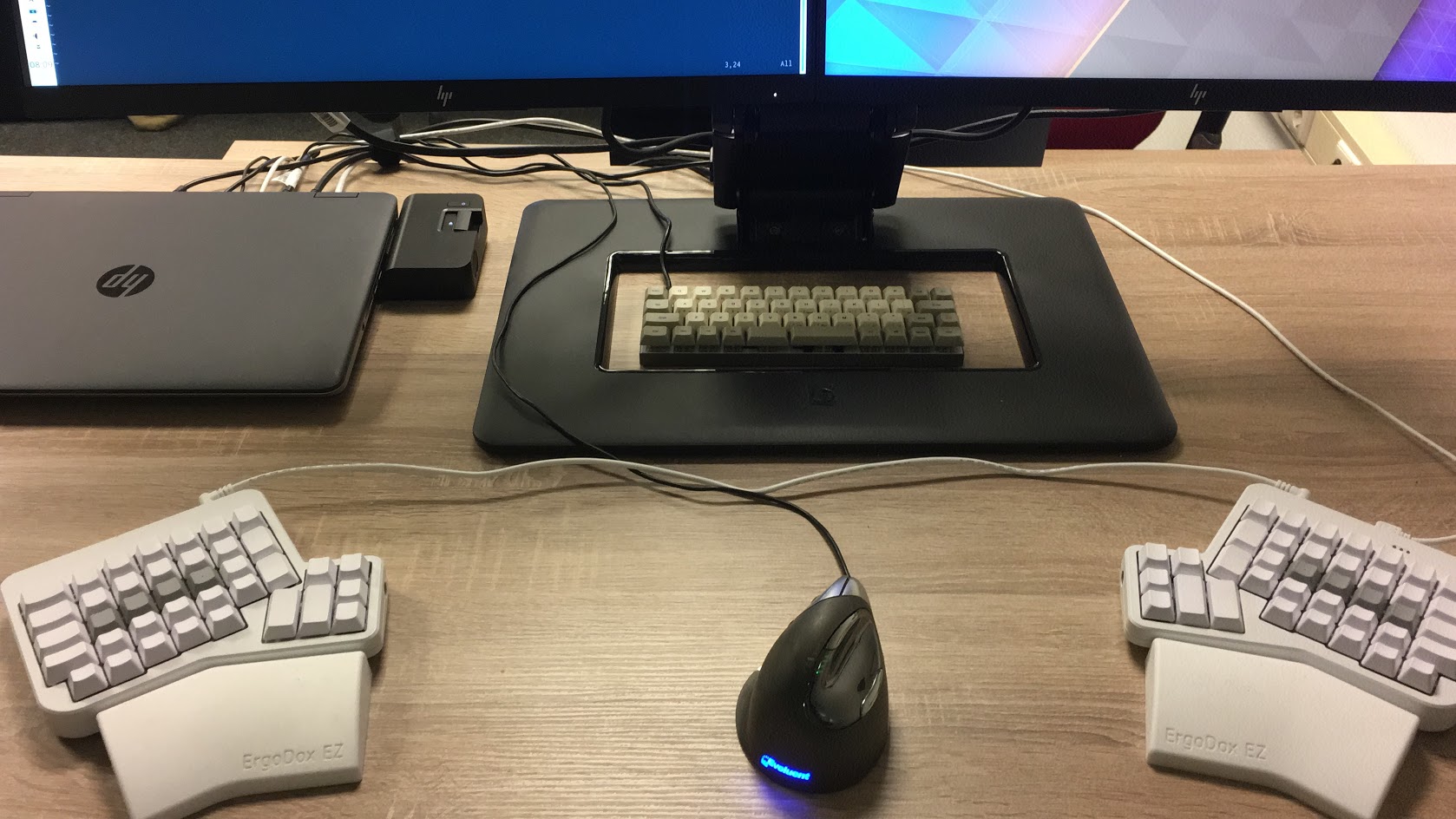
My current desk, with an ErgoDox EZ white, Evonluent Vertical Mouse (left handed) and a Vortex Core keyboard.
I've been using split keyboards for about five years now. Over those years I've tried several different models from different manufacturers. In this article I'll talk about the three split keyboards I've used intensively and two I have only seen or tried shortly. We'll start with my current and favorite split keyboard, the ErgoDox EZ. The other two I've used are the Matias Ergo Pro and the Kinesis Freestyle 2. I discuss the UHK and Microsoft Natural Ergonomic Keyboard 4000 briefly.
I love the ErgoDox EZ. It's a mechanical keyboard, in my case with Cherry MX brown switches. The layout is customizable, you can reassign keys and layers can be added and edited. More on layers later in this article. It's quite expensive at EUR 300 but well worth the price. If you're typing for eight hours a day you would want the best tool there is to do that right? The ErgoDox fits that bill perfectly.
My friend Wesley has a great article on mechanical keyboards and why you need one. I find the typing experience more pleasant. It does not feel mushy like a regular rubber dome keyboard, and you don't have to press the keys all the way down for a keypress to register.
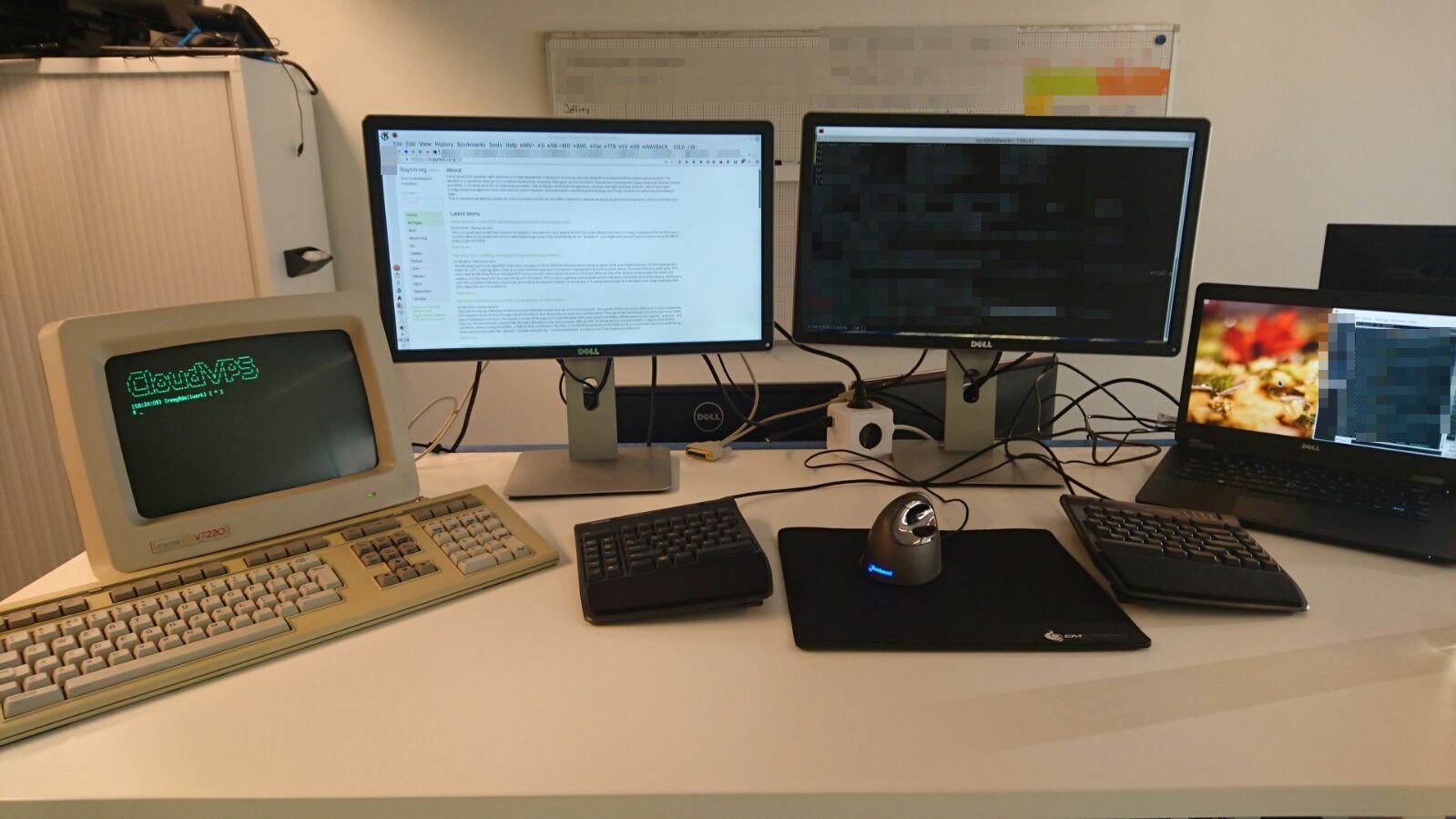
My standing desk at CloudVPS with the Kinesis Freestyle 2. Oh and a DEC vt220.
I've settled on the Ergodox EZ due to the quality and customizability. The Matias Ergo Pro broke after a few months, and the Kinesis Freestyle 2 isn't mechanical. I'd give the Ergodox a 10/10 and recommend it to everyone.
Ergodox EZ
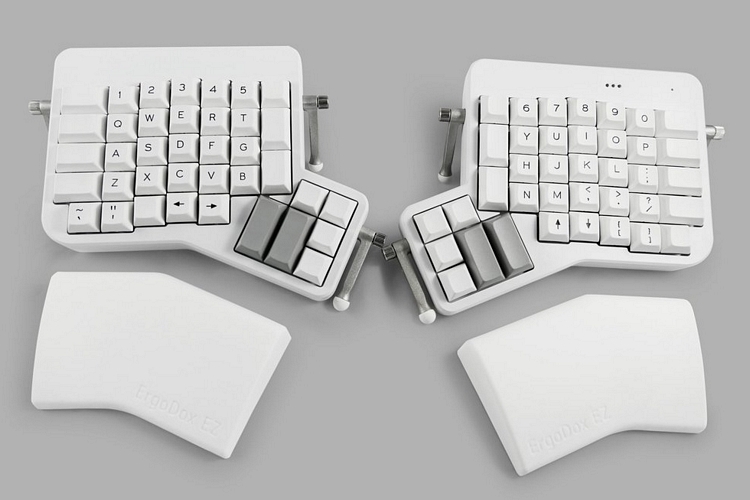
At home I have a black Ergodox EZ with MX blue switches, those are clicky and noisy. Not suitable for an office, which is why I have two ergodox keyboards. The office version is white with MX browns. Still tactile but not as much noise as the blue switches.
There are no letters on my keycaps because the layout of the ergodox is
customizable. In my case, a qwerty layout with some modifier keys changed (like
tab, escape, backspace/delete). You can view my layout here. I've given the
curly brackets, tilde and percent sign ({ % } ~) their own key due to me using
them a lot (python/jinja templates and in the shell). The ergodox is also
available with keycaps of course.
The Ergodox EZ comes with an ortho-linear layout. What this means is that the keys are lined up exactly on top of each other. This layout reduces finger travel and fatigue. Here is a picture of the default layout of the ErgoDox:
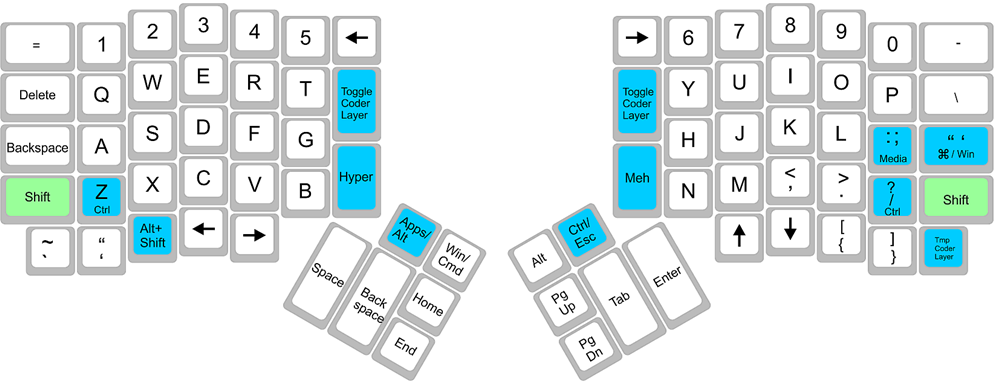
It took me about a month to get used to the ergodox layout. I printed it out and placed it on my desk, which helped a lot. I do prefer the wrist rests but not the tilt kit. My first Ergodox included the tilt kit, however, I never use it. My second ergodox doesn't have the tilt kit.
One other very nice feature of the Ergodox is the thumb cluster:

On a regular keyboard, you only use your thumbs for the space bar. The ergodox
has a thumb cluster on each half. It includes six keys you can use with your
thumb. The position is comfortable, and it enables you to use your thumb for
more than just the space bar. The keys on the left thumb cluster include
space, backspace, home and end. I've added the backtick/tilde (~) and
the percent sign (%) since I use those often.
The right thumb cluster includes CTRL, ALT, PGUP, PGDOWN, TAB and
ENTER. The arrow keys are on the outskirts of the regular layout; I hit them
with my thumbs so I include them in the thumb cluster. Not suitable for gaming,
but excellent for typing.
The two halves connect with a TRRS cable (headphone cable with two male connectors) and the board itself is connected via Mini-USB from the right half to the computer. The right half has three LED's which indicate which layer you are on.
The concept of layers can be daunting at first. It is best compared with the shift key or the caps lock key. If you press and hold shift, or enable caps lock, the letter keys will provide something different (capital letters, or symbols in case of the number keys). Layers on the Ergodox allow you to define more of those like shift or caps. Layer 0 is the regular QWERTY layer. The Ergodox does not have a function key row (F1, F2, etc.) or a Numpad. If you enable layer 1, the number keys will act as function keys, and there is a numpad. You can trigger a layer for one keypress by holding a key (like shift) and pressing the key you want on the other layer or switched to by pressing and releasing a key (like caps). Until you press that key again, you're on that layer.
Layer 3 on the ErgoDox has mouse keys (to move the mouse cursor) and media controls. You can setup mouse controls on any keyboard as you can read in my article.
All of these layers can be customized and changed to your liking. If you're an avid user of an application that has many shortcuts (like Adobe's suite or Excel) you could benefit significantly from a specific layer for that program. You configure the layout via a webpage (or via the open source QMK firmware the Ergodox runs, if you're into that).
The build quality of the ErgoDox EZ is very well. The keycaps feel comfortable, the housing is sturdy, and the wrist rests are massive. The wrist rests do get dirty quickly, but nothing that a wet cloth can't fix.
The ErgoDox is open source; you can download the PCB files or buy a kit to solder a keyboard yourself.
The price is quite high; I paid USD 350 for the black one and USD 300 for the white one. With shipping and import tax both in the end cost me around EUR 400. But I must say, well worth the price.
Matias Ergo Pro
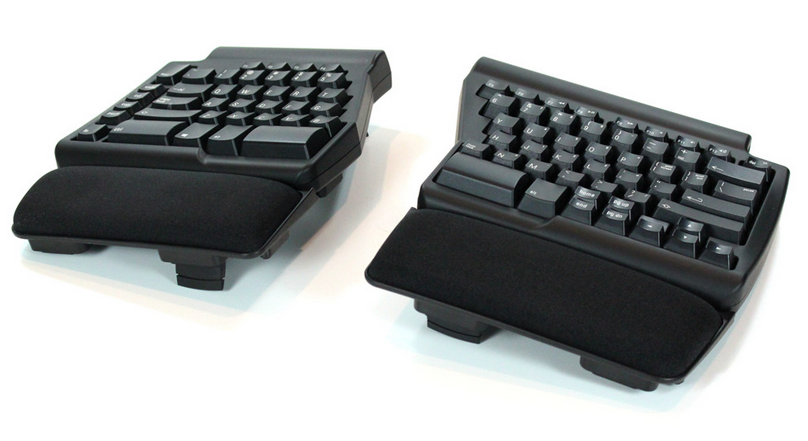
My first split keyboard was the Matias Ergo Pro. It's a mechanical keyboard with Matias quiet switches, clones of ALPS switches. These switches are quitet but have a tactile bump. More quied than MX browns so suitable for office use.
I bought the Matias because the ergodox back then was only available as a kit and I didn't want to solder my keyboard. The wrist rests are the best I've ever had, but the keyboard itself was not that great.
I couldn't get used to the layout, and the keyboard is not programmable. The N
key was in the wrong position (there is a key next to it, num lock, which I kept
hitting whenever I wanted to hit the N key. There is no thumb cluster (I
wasn't aware of it back then, but looking back I don't want anything else
anymore) and there are some other unused keys for me.
The second issue with the Matias, it broke after a few months. One half of the keyboard got random ghost typing. It typed the wrong characters, or it typed out of itself. These issues would disappear whenever I disconnected and reconnected the keyboard.
The third issue, some of the switches broke. My B key didn't function anymore.
Last but not least, the wrist rests started leaking. The rests have a gel-like substance in them, after a small puncture, started oozing out slowly.
Since the keyboard shipped from Canada warranty was quite hard to get. I did get a new set of wristrests from them but had to pay customs tax over that. Not something they can fix. The support, however, was quick and helpful. I stopped using the Matias Ergo Pro after four months. Due to the high price of the board, around EUR 200 and the issues I experienced with it, I wouldn't recommend it.
Kinesis Freestyle 2
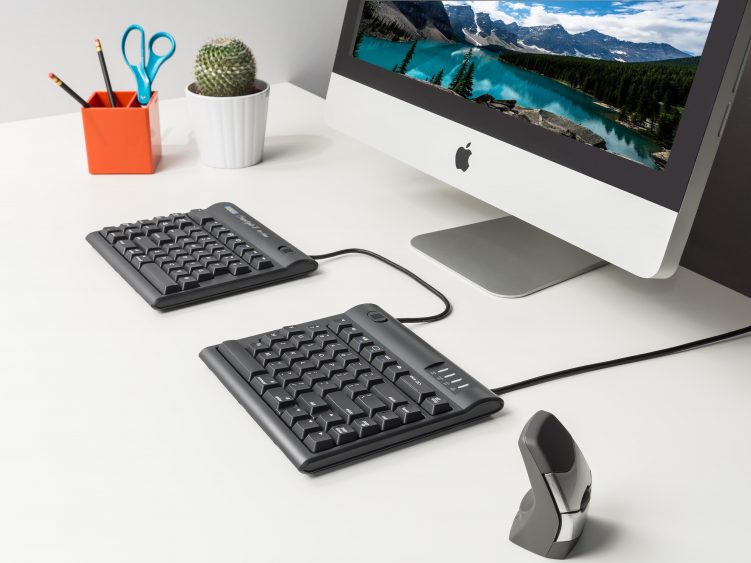
This keyboard is by far the cheapest split keyboard. I bought it for EUR 80. It is not a mechanical keyboard (so it is mushy to type on) and the wrist rests are just a bit of cloth on plastic, quite hard (as compared to the ergodox or Matias wrist rests).
Other than those two issues, I like this board. It's my lend-out split keyboard which I give to other people who want to try a split keyboard. Not only because it is cheap, but also because the layout is just regular. It has a function key row and dedicated arrow keys in the place you expect them to be. The keyboard can be put apart (up to 20 cm) just as the Ergodox or the Matias.
The cable to connect the two halves is integrated, however. The Matias and Ergodox have a separate TRRS cable (sort of male-male headphone cable) which you can replace if it breaks. With the Kinesis that is not possible. The halves can also be clicked together to provide an angled setup, which is easy for people who start with a split keyboard.
Kinesis provides a tilt kit (to raise the keyboard) including wrist rests, named the vip3. I have that kit and with this keyboard, it's nice that you can raise it. Kinesis also provides a vertical kit, as shown below:
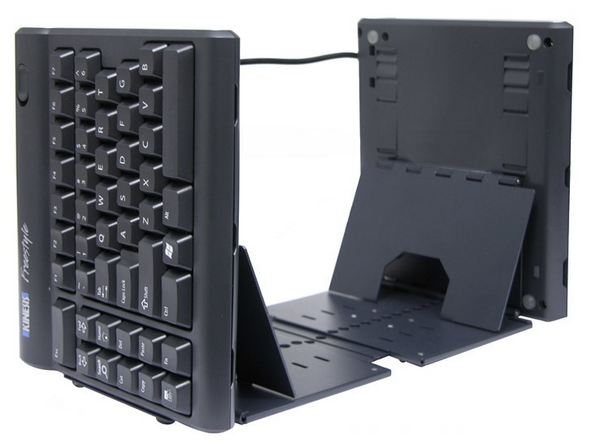
With that kit, you can have the keyboard vertical. I've never tried it but I do use a vertical mouse. The vertical position puts your lower arm in a more relaxed position. I like the vertical mouse, but I doubt about this kit. Due to the function key row on the left half, you would have to raise your hand quite a bit to hit the actual keys which might provide more tension.
This keyboard would be near-perfect if Kinesis dropped the large function row on the left. I never use it and it's not customizable, for me just wasted space. Kinesis created a gaming version which is mechanical and includes a Windows application to remap the keys, the Freestyle Edge. It still includes the large function row on the left. The price is around EUR 250 so that is a huge step up from the EUR 80 for just mechanical switches. I have not used the Edge so I cannot comment with actual experience.
Due to the price being as low as it is compared to other split keyboards, around EUR 80, this is a great split keyboard to get started with. If you like split keyboards, you can experiment further with the Ergodox or other options. If you don't like it, you can click the halves together and you haven't wasted a ton of money. It might not be the ideal keyboard for me, but nontheless it is an excellent keyboard for its price.
UHK (Ultimate Hacking Keyboard)
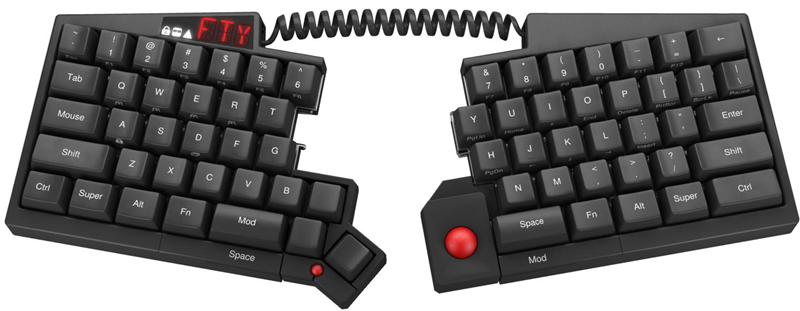
The UHK is a fully programmable mechanical split keyboard. It has add on modules to provide a thumb cluster which include a set of keys, a trackball or touchpad. It can be clicked together to provide a normal (non-split) keyboard. I have not used this board.
Looking at the pictures and the youtube reviews I think I might like it due to the layout and flexibility in addons and programming. A trackball integrated in my keyboard seems awesome, even less hand movement. Also, the possibility to click the keyboard together into a regular, mechanical keyboard seems cool for the people who want that.
Price is comparable to the ergodox at around EUR 310 for a base board. The trackball and key cluster add-ons are not available at the moment (no ETA) but do cost EUR 70 each. If you want two (one for each half), you are looking at a total of around EUR 460.
Microsoft Natural Ergonomic Keyboard 4000 & Sculpt
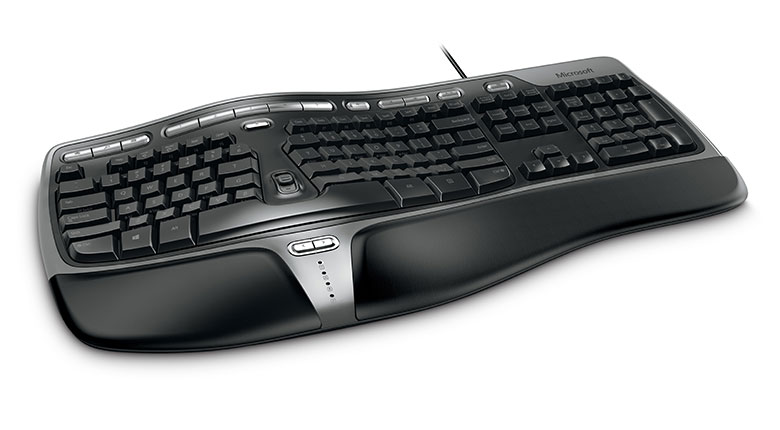
Microsoft has the Natural Ergonomic Keyboard 4000. It's a split keyboard in the sense that it has more spacing and an angle between two keyboard parts. It is not a split keyboard in the sense that it is seperated into two parts. Another co-worker has this board and is very pleased with it. It has a scroll wheel in the middle, function keys and a numpad. It can be raised and has a wrist rest. It feels like a high quality keyboard. Price is around EUR 40. I've only touched it a little (haha) but I don't think I would like it. It's not mechanical and the split angle is wrong for my arms.
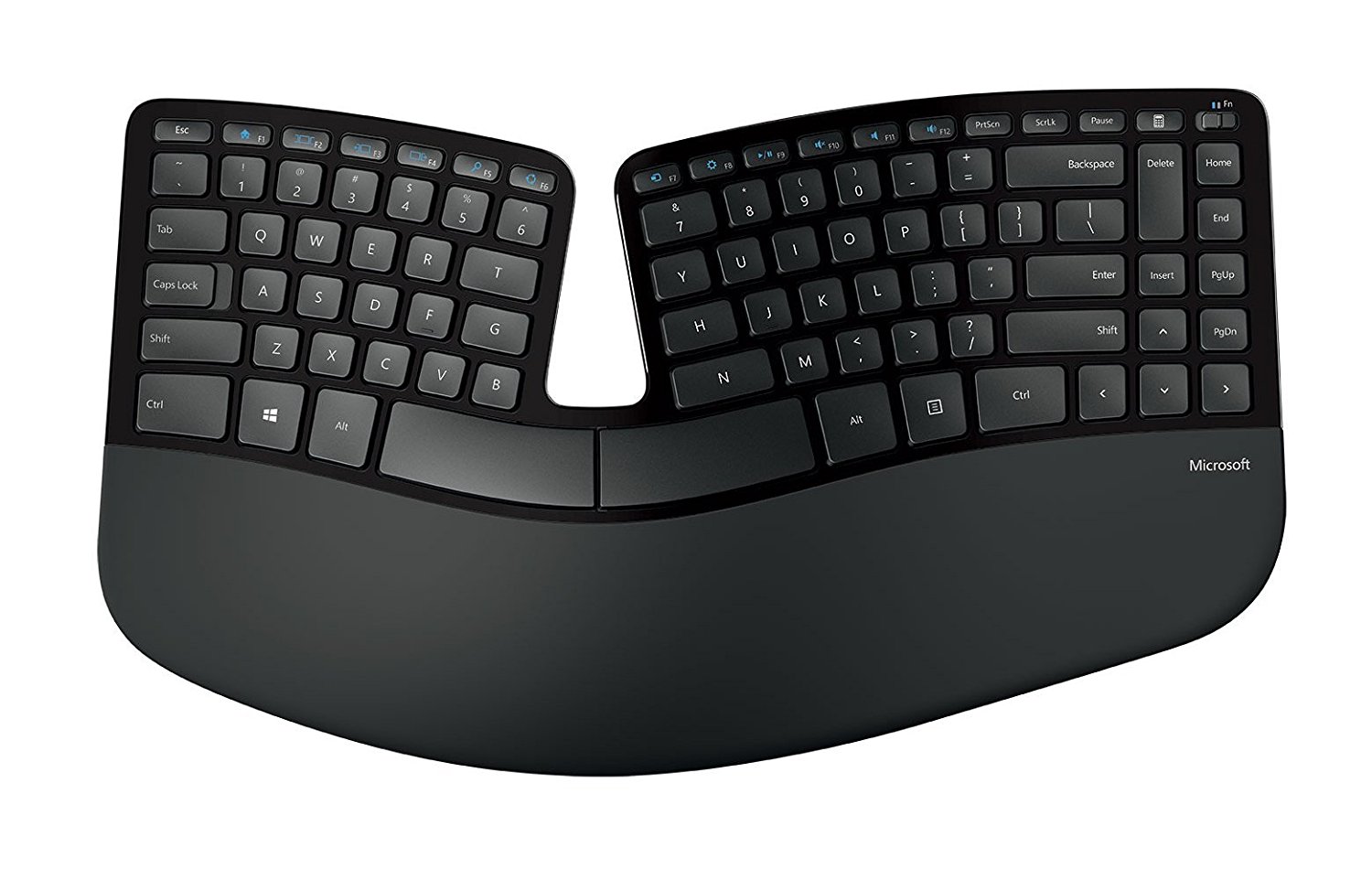
Microsoft also has the Sculpt. It's wireless (with a non-replacable dongle) and has butterfly switches. (Like laptop keys). I would probably go nuts if I had to use it. I wouldn't like the key feel and the angle seems the same as the other Microsoft board, which hurts my wrists. Non-adjustable as well. Price is a bit higher at EUR 90.
Tags: articles , dec , ergodox , ergonomic , keyboard , kinesis-freestyle , matias-ergo-pro , mechanical-keyboard , mechanical-keyboards , qmk , split-keyboard , vt220